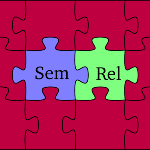Analogies in German Particle Verb Meaning Shifts
- Typ
-
ExperimentData
- Autoren
-
Maximilian Köper und Sabine Schulte im Walde
- Ressource
-
German particle verbs (PVs) often trigger meaning shifts of the base verbs (BVs). For example, the two sound BVs brummen "to hum" and donnern "to rumble" both describe a displeasing loud noise. Combining them with the particle auf, the PVs aufbrummen and aufdonnern are near-synonyms in one of their senses, roughly meaning "to forcefully assign a task".
We collected human judgements for analogy combinations of BV–PV pairs of the form BV1:PV1::BV2:PV2 such as
klappern:abklappern::klopfen:abklopfen,
focusing on the four highly frequent particle types ab, an, auf, aus. In total, we collected 794 analogy questions, ca 200 per particle type. The BV–PV pairs were annotated by five German native speakers with a background in linguistics. The annotators were asked to classify the analogies into four categories to distinguish between meaning shifts in no/one/both BV–PV pairs:- Comp: no BV–PV pair has a meaning shift, i.e., both PVs are compositional regarding their BVs, and therefore all four verbs are (near-)synonyms.
- AsymComp: only one of the BV–PV pairs undergoes a meaning shift; in this case, the annotators also indicated that pair.
- ShiftDiff: both BV–PV pairs show a meaning shift, but the BVs are not semantically similar.
- ShiftReg: both BV–PV pairs undergo a meaning shift, and the BVs are semantically similar.
Despite a distinction into four categories per instance, we obtained a moderate Fleiss' kappa=0.43 as the mean across the four particles. We transformed the annotations to actual class assignments by removing all instances from the dataset without a category majority, i.e., we only included BV–PV analogy pairs where at least 3 out of 5 annotators agreed on the shift category. We assigned the majority decision as class label. The final collection still contains 685 analogy pairs.
- Referenz
-
Maximilian Köper, Sabine Schulte im Walde (2018)
Analogies in Complex Verb Meaning Shifts: The Effect of Affect in Semantic Similarity Models
In: Proceedings of the 16th Annual Conference of the North American Chapter of the Association for Computational Linguistics: Human Language Technologies (NAACL-HLT). New Orleans, LA. - Download
SemRel

Forschergruppe SemRel
- E-Mail schreiben
- Forschergruppe Sabine Schulte im Walde

Sabine Schulte im Walde
Prof. Dr.Akademische Rätin


